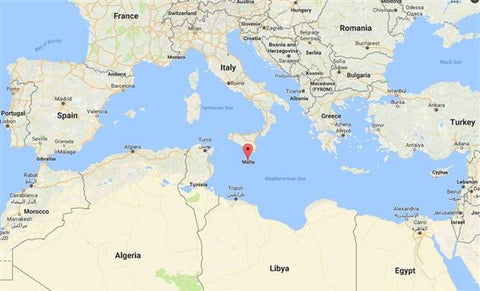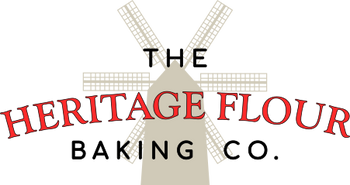The Heritage Flour Baking Co. Story
The story of Heritage Flour Baking Company begins with the story of our founder, Mariella Frazier and unfolds through multiple chapters.
Chapter 1: The Malta Connection

 I grew up with cannoli and cassata siciliana but also plum pudding, and Christmas cake. I lived the first twenty one years of my life on the island of Malta, in the Mediterranean, 60 miles south-west of Sicily. Malta's many, many layers of history go back to prehistoric times. It has been settled, conquered or colonized by every power that swept through Europe over the centuries, including the Normans, Spain, Sicily, the Arabs, the French and more recently the British. This long relationship between the island and occupying civilizations also left its mark on our food and explains our eclectic culinary heritage.
I grew up with cannoli and cassata siciliana but also plum pudding, and Christmas cake. I lived the first twenty one years of my life on the island of Malta, in the Mediterranean, 60 miles south-west of Sicily. Malta's many, many layers of history go back to prehistoric times. It has been settled, conquered or colonized by every power that swept through Europe over the centuries, including the Normans, Spain, Sicily, the Arabs, the French and more recently the British. This long relationship between the island and occupying civilizations also left its mark on our food and explains our eclectic culinary heritage. At age twenty one I married an American Navy pilot and moved to the United States. It probably goes without saying that one of the things I missed the most once I came here was the food I grew up with, and so it was inevitable that I eventually learnt to duplicate these dishes in my own kitchen. This grew into a lifelong love-affair with cooking. Cooking became a link to my past and a continent, and its people, across the sea. And cooking connected that old world to my new family and friends here every time I chose to share with them a dish from my past.
At age twenty one I married an American Navy pilot and moved to the United States. It probably goes without saying that one of the things I missed the most once I came here was the food I grew up with, and so it was inevitable that I eventually learnt to duplicate these dishes in my own kitchen. This grew into a lifelong love-affair with cooking. Cooking became a link to my past and a continent, and its people, across the sea. And cooking connected that old world to my new family and friends here every time I chose to share with them a dish from my past.
Chapter 2: My First Bakery Business
Soon I found myself making cannoli, and have been now making them by hand for over thirty years. This was the first product I ever sold, to a local restaurant, and led to my first food business. My family and country's recipes of old, classic, traditional European pastries and other baked goods were the heart and soul of this business.
I baked the way my mother did, and the way your grandmother used to, without preservatives or additives, making everything from scratch in small batches, using wholesome organic ingredients, locally and seasonally sourced where possible. I had always known what good food should taste like and now it gave me the utmost pleasure to preserve those qualities for others to enjoy as well.Chapter 3: A New Interest in Ancient Grains
I was two years into re-launching my European specialty bakery, when I decided to look further into gluten-free flours, having come to realize there was a demand and a bonafide need for that kind of product. Many of the GF flours out there such as amaranth, millet, teff, etc., are ancient grains and each was an important food source for ancient civilizations, but they are technically pseudo-cereals, and to substitute them for wheat flour in the older traditional recipes I would have needed to add in other ingredients that one would never have found in the original recipes. This was a huge stumbling block to me, and one I chose not to overcome. There had to be another answer.
So I kept at the research some more, and this was when I stumbled upon another world of ancient grains, that of the original, very early grasses of the Triticum (wheat) species from which modern flour was later developed. The more I read about these forgotten ancestral flours, their wholesome goodness and superior nutritional value, especially when compared to modern-day wheat, the more I became convinced that this was the path for me.
My bakery was already doing a lot of things right: we were baking from scratch, using organic, seasonal ingredients, and sourcing locally where possible. Now that I had been made aware that there were much healthier alternatives to the flour I was using it was time to bring those flours, flours like einkorn, kamut, one or two varieties of pure spelt and a couple of other heritage flours into my kitchen. That was in the Spring of 2016.
Chapter 4: A Flour Revolution
Much happened in the two years since early 2016. I found myself focusing more and more on "flour", which, as the primary ingredient in most all baked goods, should be the star of the show. But not all flours are created equal. The ancient flours we've been working with are incredible. They are rich in flavor and richer in vitamins and minerals than modern wheat. Unlike modern wheat, the gluten found in these particular flours is often well tolerated by people who are otherwise gluten intolerant. I’ve been encouraging everybody to read up on them, get familiar with them and start using them.
I am a latecomer to the revolution underfoot that is aiming to reclaim the nutrition and goodness these older flours provided, but I am committed to doing what I can, and it was for this reason that we added a new Baking Mix product line using these flours.
Chapter 5: The Heritage Flour Baking Company is Born!

I now go around with a new vision in my head. There are others around me, in this country, and throughout the world, farmers, chefs, professional bakers, home bakers, folks who like me were puzzled by the notion that a commodity that once sustained and nourished civilizations could turn bad and was contributing to making people less healthy. We all believe there is a lot wrong with modern wheat products beyond the flour itself, but that the first step to changing that has to be to re-introduce and bring back the good flours, the flours of old. So now "flour" has moved to center-stage and it is now all about the flour. No longer is my ambition just to produce the most delectable, and at the same time better for you European pastry, but I feel a need to take a step back and start at a more basic level, where the focus is the flour. It was with this in mind that The Heritage Baking Co. and its line of products was born.
Thank you for joining us on this journey into exploring the world of heritage flours and wholesome baking.
-- Mariella Frazier, Founder
